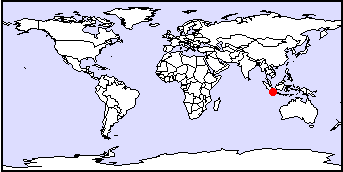 |
 |
 |
 |
Town/City: |
Jakarta |
State/Province: |
DKI Jakarta |
Country: |
Indonesia |
Latitude/Longitude: |
107 E 6 S |
Information supplied by
Haryadi Tirtomihardjo
|
|
Jakarta is the capital of the Republic of Indonesia which is bordered by Java Sea in the North and West Java Province in the South (Kabupaten Bogor), West (Kabupaten Tangerang), and in the East (Kabupaten Bekasi). The province of Jakarta (DKI Jakarta) is geographically located in area of latitude 6o00'-6o20' S and longitude 106o42'-107o00' E.
DKI Jakarta and its surrounding which is so called Jabotabek (Jakarta, Bogor, Tangerang, Bekasi) covers a surface area of appoximately 7,200 km2. Jabotabek relies on groundwater resources located within inside the area and on surface water resources within and outside its area. For this reason the area has a regional character.
The surface area of DKI Jakarta is about 652 km2. The population of Jakarta, which was about 800,000 just before independece (1945) has increased to 8.2 million in 1990 according to recent census. The 1990 population Botabek (Bogor, Tangerang, Bekasi) was about 8.78 million, making a total of 17 million for Jabotabek. The annual increase over 1980 - 1990 periode has been 2.41 %. In the year 2005, the population of DKI Jakarta is estimated to be 12 million while the population of Jabotabek will have 23.4 million. Unlike other region, over 75 % of this population is in an urban setting.
Based on Master Plan of DKI Jakarta 1985-2005, the future land use planning with respect to areas of groundwater consumption, pollution, and recharge had been devided into three regions. These are the (1) Main Areas of Industrial and Commercial Development (15%) which has high water consumption, potential sources of pollution, limited recharge, (2) Main Areas of Greenland and Agricultural Use (35%) which has low water consumption, favourable for recharge, partly sources of pollution, (3) Housing and Commercial Areas (50 %) which has medium to high water demand, potential sources of pollution, limited recharge. Actual land use in DKI Jakarta lies within the future development boundaries. Areas outside DKI Jakarta, except of large dwellings and some industrial establishments along the main roads, are mainly use for agriculture.
Long-term mean monthly temperature is between 26 and 28 C, while the mean annual is at 27oC. The mean potential evapotranspiration for Jakarta area was calculated to be 1,606 mm/year.
The bottom of the system is formed by impermeable Miocene sediments which also crop out at the southern boundary of the system. The Basin fill which consist of marine Pliocene and Quarternary sand and delta sediments is between 0 and more than 300 m thick. The thickness of single sandy aquifer layers intercalated with a predominantly silty/clayey sequence is only between 1 and 5 m and is only 20 % of the total fill. Fine sand and silt is very frequence component of aquifers.
The horizontal permeability (Kh) of tested layers was found to be between 0.1 m/day and 40 m/day. Transmissivity (T) for the entire Quarternary sequence of 250 m thickness are some 250 m2/day near the coast and increase to about 500 m2/day near hinge line about 20 km to the south. The vertical permeability (Kv) is estimated as varying between 1/100 and 1/5000 of the horizontal permeability. The Quarternary aquifer can generally divided into three aquifer systems on the basis of the hydraulic characteristics and depths; these are: (1) Phreatic Aquifer System (0-40 m), (2) Upper Confined Aquifer System (40-140 m), and (3) Lower Confined Aquifer System (> 140 m).
Under natural flow conditions the recharge area of the deep aquifer system was situated in the hilly area at topographical elevations of between 25 and 200 m. Discharge from the confined aquifer to the natural base level in the flat coastal area occured mainly by upward leakage, evapotranspiration and outflow to the surface water system. Today, recharge to the deep aquifer system, other than horizontal inflow, may occur throughout the city area by downward leakge, as head levels of the confined aquifer system have dropped regionally below the water table of the unconfined shallow aquifer system. The shallow (phreatic) aquifer is still fully replenished during years of normal rainfall (1,700 mm/year near the coast, 2,900 mm/year near Depok). Discharge from the deep aquifer system in 1995 is almost exclusively due to pumping from deep water wells.
Groundwater quality in general was very good at the beginning of this century but in the toplayers of the coastal plain deposits was slightly brackish to saline. At present, the exploitation of deep groundwater has caused salinization of the deep aquifer, whereas the rapid urbanization and the high population densities within the urban areas have led to the contamination of the shallow aquifer.
The groundwater contribution to the actual supply is about 250 million m3/year and is mainly abstracted from innumerable shallow wells (80 %) and more than 3,000 deep wells (20 %). Between 1900 and 1950, groundwater abstraction was below 10 million m3/year but since that time, mainly after 1970, it has steadily increase in step with the growth in population and industrial development. In the year 1994, deep groundwater abstraction was estimated 53 million m3/year which was about 50 % higher than that of registered wells (33.8 million m3/year).
Actual groundwater abstraction of about 53 million m3/year from deep wells can not be compensated by horizontal inflow across the hinge line (estimated to be some 15 million m3/year) and by vertical leakage from the shallow aquifer. In response to overabstraction, water levels dropped by 1-3 m/year during the last 10 years and are locally at 20-40 m below mean sea level.
Data more than 200 wells has been used by DEG in 1994 to indicate the zone of groundwater quality problem. It is observed that shallow groundwater quality is affected (Cl-=500 ppm and EC=1,500 micromhos/cm) in Jakarta as far as 9 km inland (Cengkareng Pedongkelan, Pulogadung). The salinity in the deeper aquifer system (40-140 m) and greater than 140 m has progressively moved southward, reaching 3-7 km inland. The water quality in the shallow aquifer which still supplies 80 % of the Jakarta population with drinking water, is also highly endangered by human pollution in the densely populated city area.
Land subsidence is now identified as the most critical problem, because it occurs on a large scale in northern Jakarta. Geotechnical model calculations strongly support the hypothesis that confined groundwater abstraction is the main cause of the observed land subsidence (10 to 90 cm in the period 1978-1989/90, more than 50 cm in a zone of approximately 150 km2). Simulation runs make plausible that the total land subsidence in uncrolled conditions may increase to 5 times the values already observed. This mean a total final subsidence from 1950 onwards of 4 to 6 meters in the most subsidence prone zones in northern Jakarta.
1. In Northern Jakarta, groundwater management focusses at:
Haryadi T., Wishnu W., (1995): Konservasi Airtanah di Wilayah DKI Jakarta - Tangerang, Direktorat Geologi Tata Lingkungan, Bandung - Indonesia (unpublished). Ramu K.V, (1991): Conjunctive Resource Management of Surface and Groundwater - The Jabotabek Case Study, Seminar Pengembangan Airtanah, University of Trisakti - Jakarta (Indonesia). Schmidt G., Haryadi T., Kohler G., (1985): Jakarta Groundwater Study - Groundwater Modelling, Working Paper (HAG) 116, Directorate of Environmental Geology - Bandung (Indonesia), Federal Institute of Geosciences and Natural Resources - Hannover (Germany). Soefner B., et al. (1985): Jakarta Groundwater Study - Working Paper (HAG) 117, Directorate of Environmental Geology - Bandung (Indonesia), Federal Institute of Geosciences and Natural Resources - Hannover (Germany). Su He-Yuan, Zhang Hian-Lin (1993): A supplemental Investigation of Land Subsidence and Planning on Setting up an Extensometer Monitoring System in Jakarta Metropolitan Area, Consultant Report, Directorate of Environmental Geology - Bandung (Indonesia). Rismianto D., Mak W., (1994): Groundwater Problems in Jakarta and Their Implications for Piped Water Supply, Simposium Air Jakarta 1994, Pusat Pengkajian Perkotaan Universitas Tarumanegara, Jakarta (Indonesia).Back to Topics